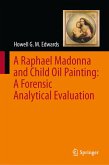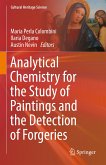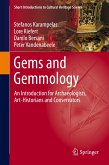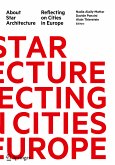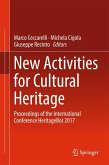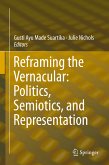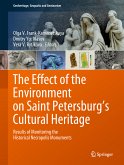Historic Mortars (eBook, PDF)
Characterisation, Assessment and Repair
Redaktion: Válek, Jan; Groot, Caspar J. W. P.; Hughes, John J.


Alle Infos zum eBook verschenken

Historic Mortars (eBook, PDF)
Characterisation, Assessment and Repair
Redaktion: Válek, Jan; Groot, Caspar J. W. P.; Hughes, John J.
- Format: PDF
- Merkliste
- Auf die Merkliste
- Bewerten Bewerten
- Teilen
- Produkt teilen
- Produkterinnerung
- Produkterinnerung

Hier können Sie sich einloggen

Bitte loggen Sie sich zunächst in Ihr Kundenkonto ein oder registrieren Sie sich bei bücher.de, um das eBook-Abo tolino select nutzen zu können.
This volume focuses on research and practical issues connected with mortars on historic structures.
The book is divided into four sections: Characterisation of Historic Mortars, Repair Mortars and Design Issues, Experimental Research into Properties of Repair Mortars, and Assessment and Testing. The papers present the latest work of researchers in their field. The individual contributions were selected from the contributions to the 2nd Historic Mortars Conference, which took place in Prague, September, 22-24, 2010. All papers were reviewed and improved as necessary before publication. This…mehr
- Geräte: PC
- ohne Kopierschutz
- eBook Hilfe
- Größe: 19.32MB
![A Raphael Madonna and Child Oil Painting: A Forensic Analytical Evaluation (eBook, PDF) A Raphael Madonna and Child Oil Painting: A Forensic Analytical Evaluation (eBook, PDF)]() Howell G. M. EdwardsA Raphael Madonna and Child Oil Painting: A Forensic Analytical Evaluation (eBook, PDF)105,95 €
Howell G. M. EdwardsA Raphael Madonna and Child Oil Painting: A Forensic Analytical Evaluation (eBook, PDF)105,95 €![Analytical Chemistry for the Study of Paintings and the Detection of Forgeries (eBook, PDF) Analytical Chemistry for the Study of Paintings and the Detection of Forgeries (eBook, PDF)]() Analytical Chemistry for the Study of Paintings and the Detection of Forgeries (eBook, PDF)81,95 €
Analytical Chemistry for the Study of Paintings and the Detection of Forgeries (eBook, PDF)81,95 €![Gems and Gemmology (eBook, PDF) Gems and Gemmology (eBook, PDF)]() Stefanos KarampelasGems and Gemmology (eBook, PDF)48,95 €
Stefanos KarampelasGems and Gemmology (eBook, PDF)48,95 €![About Star Architecture (eBook, PDF) About Star Architecture (eBook, PDF)]() About Star Architecture (eBook, PDF)129,95 €
About Star Architecture (eBook, PDF)129,95 €![New Activities For Cultural Heritage (eBook, PDF) New Activities For Cultural Heritage (eBook, PDF)]() New Activities For Cultural Heritage (eBook, PDF)153,95 €
New Activities For Cultural Heritage (eBook, PDF)153,95 €![Reframing the Vernacular: Politics, Semiotics, and Representation (eBook, PDF) Reframing the Vernacular: Politics, Semiotics, and Representation (eBook, PDF)]() Reframing the Vernacular: Politics, Semiotics, and Representation (eBook, PDF)40,95 €
Reframing the Vernacular: Politics, Semiotics, and Representation (eBook, PDF)40,95 €![The Effect of the Environment on Saint Petersburg's Cultural Heritage (eBook, PDF) The Effect of the Environment on Saint Petersburg's Cultural Heritage (eBook, PDF)]() The Effect of the Environment on Saint Petersburg's Cultural Heritage (eBook, PDF)53,95 €
The Effect of the Environment on Saint Petersburg's Cultural Heritage (eBook, PDF)53,95 €-
-
-
The book is divided into four sections: Characterisation of Historic Mortars, Repair Mortars and Design Issues, Experimental Research into Properties of Repair Mortars, and Assessment and Testing. The papers present the latest work of researchers in their field. The individual contributions were selected from the contributions to the 2nd Historic Mortars Conference, which took place in Prague, September, 22-24, 2010. All papers were reviewed and improved as necessary before publication. This peer review process by the editors resulted in the 34 individual contributions included in here. One extra paper reviewing and summarising State-of-the-Art knowledge covered by this publication was added as a starting and navigational point for the reader.
The editors believe that having these papers in print is important and they hope that it will stimulate further research into historic mortars and related subjects.
Dieser Download kann aus rechtlichen Gründen nur mit Rechnungsadresse in A, B, BG, CY, CZ, D, DK, EW, E, FIN, F, GR, HR, H, IRL, I, LT, L, LR, M, NL, PL, P, R, S, SLO, SK ausgeliefert werden.
- Produktdetails
- Verlag: Springer Netherlands
- Seitenzahl: 464
- Erscheinungstermin: 23. Juni 2012
- Englisch
- ISBN-13: 9789400746350
- Artikelnr.: 37772878
- Verlag: Springer Netherlands
- Seitenzahl: 464
- Erscheinungstermin: 23. Juni 2012
- Englisch
- ISBN-13: 9789400746350
- Artikelnr.: 37772878
- Herstellerkennzeichnung Die Herstellerinformationen sind derzeit nicht verfügbar.
Two views on dealing with rain penetration problems in historic fired clay brick masonry, by Caspar J.W.P. Groot and Jos Gunneweg Chapter III : Experimental research into properties of repair mortars: Experimental study of hot mixed mortars in comparison with lime putty and hydrate mortars, by Jan Válek and Tomás Matas.- The effect of calcination time upon the slaking properties of quicklime, byDorn Carran, John Hughes, Alick Leslie and Craig Kennedy.- The hydration of modern Roman cements used for current architectural conservation, by
Christophe Gosselin, Karen L. Scrivener , Steven B. Feldman and Wolfgang Schwarz.- The effect of relative humidity on the performance of lime-pozzolan mortars, by Ioannis Karatasios, Maria Amenta, Maria Tziotziou and Vassilis Kilikoglou.- Morphological and chemical influence of calcium hydroxide on the plasticity of lime based mortars, by Deborah Klein, Sonja Haas, Sven-Olaf Schmidt and Bernhard Middendorf.- Water transport between mortar and brick: the influence of material parameters, by Roel Hendrickx, Staf Roels and Koenraad Van Balen.- Problems in the assessment of the stress-strain relationship of masonry, by Claudia Neuwald-Burg and Matthias Pfeifer.- Influence of the mechanical properties of lime mortar on the strength of brick masonry, by Adrian Costigan and Sara Pavía.- Influence of interfacial material pore structure on the strength of the brick/lime mortar bond, by Mike Lawrence, Pete Walker and Zhaoxia Zhou.- Grouts for injection of historical masonries: influence of thebinding system and other additions on the properties of the matrix, by Ioanna Papayianni, Maria Stefanidou and Vasiliki Pachta.- Lime based grouts for strengthening of historical masonry buildings in Slovenia, by Mojmir Uranjek, Vlatko Bosiljkov, Roko Zarnic and Violeta Bokan Bosiljkov.- Chapter IV: Assessment and testing: Characterisation of mortars using drilling resistance measurement system (DRMS): tests on field panels samples, by Dória Costa, Ana Magalhães and Maria do Rosário Veiga.- In situ techniques for the characterisation of rendering mortars, by Ana Paula Ferreira Pinto, Rita Nogueira and Augusto Gomes.- Application of 1H NMR to the hydration monitoring of lime-pozzolan mortars, by Maria Tziotziou, Eleni Karakosta, Ioannis Karatasios, Michalis Fardis, Pagona Maravelaki-Kalaitzaki, Georgios Papavassiliou and Vassilis Kilikoglou.- Non-standard testing in characterisation and consolidation assessment of historic mortars, by Milos Drdácký.- Author Index.
Two views on dealing with rain penetration problems in historic fired clay brick masonry, by Caspar J.W.P. Groot and Jos Gunneweg Chapter III : Experimental research into properties of repair mortars: Experimental study of hot mixed mortars in comparison with lime putty and hydrate mortars, by Jan Válek and Tomás Matas.- The effect of calcination time upon the slaking properties of quicklime, byDorn Carran, John Hughes, Alick Leslie and Craig Kennedy.- The hydration of modern Roman cements used for current architectural conservation, by
Christophe Gosselin, Karen L. Scrivener , Steven B. Feldman and Wolfgang Schwarz.- The effect of relative humidity on the performance of lime-pozzolan mortars, by Ioannis Karatasios, Maria Amenta, Maria Tziotziou and Vassilis Kilikoglou.- Morphological and chemical influence of calcium hydroxide on the plasticity of lime based mortars, by Deborah Klein, Sonja Haas, Sven-Olaf Schmidt and Bernhard Middendorf.- Water transport between mortar and brick: the influence of material parameters, by Roel Hendrickx, Staf Roels and Koenraad Van Balen.- Problems in the assessment of the stress-strain relationship of masonry, by Claudia Neuwald-Burg and Matthias Pfeifer.- Influence of the mechanical properties of lime mortar on the strength of brick masonry, by Adrian Costigan and Sara Pavía.- Influence of interfacial material pore structure on the strength of the brick/lime mortar bond, by Mike Lawrence, Pete Walker and Zhaoxia Zhou.- Grouts for injection of historical masonries: influence of thebinding system and other additions on the properties of the matrix, by Ioanna Papayianni, Maria Stefanidou and Vasiliki Pachta.- Lime based grouts for strengthening of historical masonry buildings in Slovenia, by Mojmir Uranjek, Vlatko Bosiljkov, Roko Zarnic and Violeta Bokan Bosiljkov.- Chapter IV: Assessment and testing: Characterisation of mortars using drilling resistance measurement system (DRMS): tests on field panels samples, by Dória Costa, Ana Magalhães and Maria do Rosário Veiga.- In situ techniques for the characterisation of rendering mortars, by Ana Paula Ferreira Pinto, Rita Nogueira and Augusto Gomes.- Application of 1H NMR to the hydration monitoring of lime-pozzolan mortars, by Maria Tziotziou, Eleni Karakosta, Ioannis Karatasios, Michalis Fardis, Pagona Maravelaki-Kalaitzaki, Georgios Papavassiliou and Vassilis Kilikoglou.- Non-standard testing in characterisation and consolidation assessment of historic mortars, by Milos Drdácký.- Author Index.

